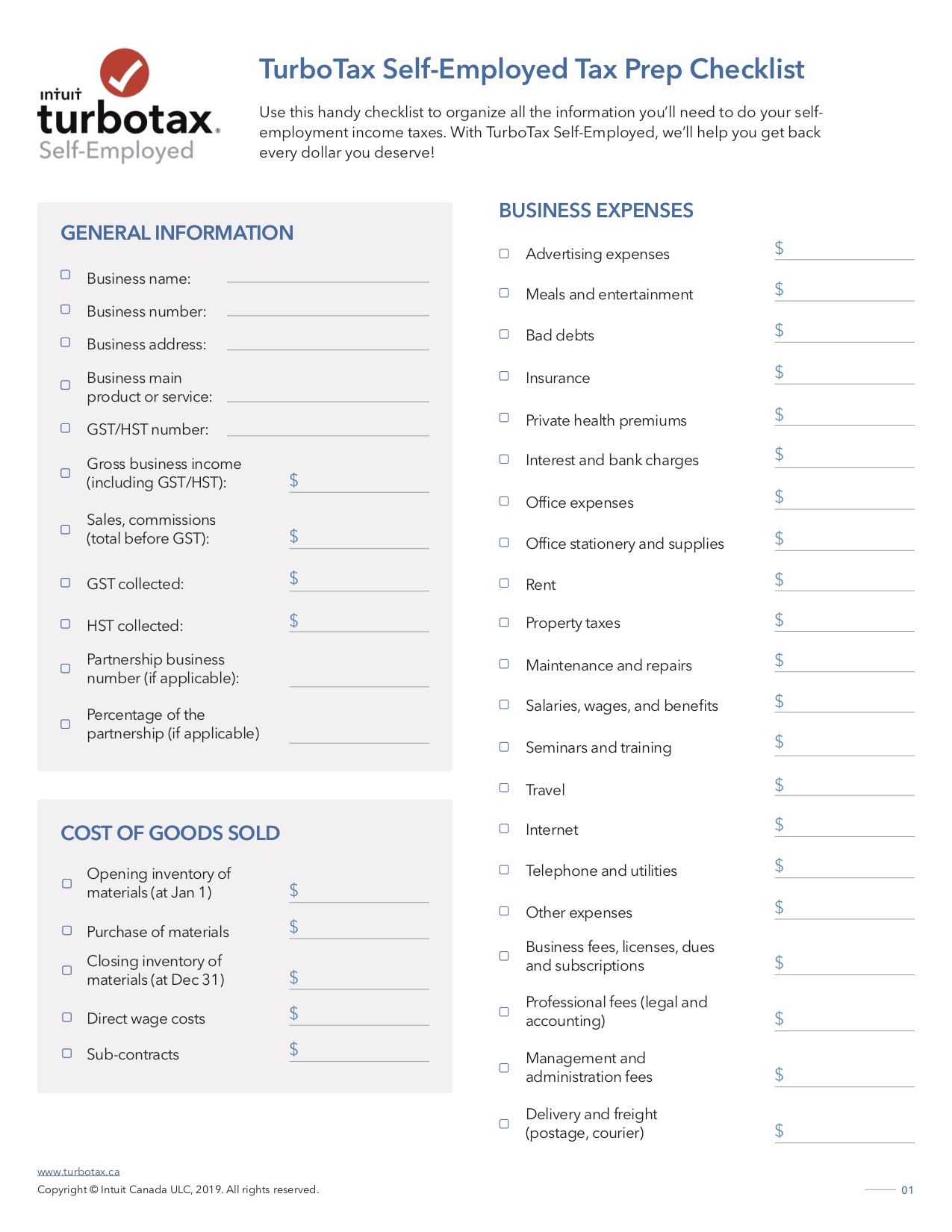The Beginner’s Guide to Self-Employed Taxes

The TurboTax Team
July 24, 2023 | 5 Min Read
Updated for tax year 2024

Being your own boss has many advantages. You have the freedom to create your own work schedule based on demand and there is no limit to your business income.
If you’ve been self-employed for a while, have a new side job, or have just made the jump from employee to self-employed, your tax situation is probably unique.
Unlike an employee, you will have to file an income tax return as a self-employed worker, as required by the Canada Revenue Agency (CRA). This means that, in addition to filing the usual tax forms, you will have to declare all your income and all your self-employed expenses.
Key Takeaways
- If you provide a product or service with the intention of making a profit you are considered self-employed.
- You can deduct your self-employed business expenses on your tax return as long as they helped you generate income.
- Self-employed tax returns are due on June 16, 2025 but any balance owed is due on April 30, 2025.
What does it mean to be self-employed?
Self-employed means that you work for yourself. So if you’re a freelancer, a home-based business owner, consultant, or a side gigger, you probably have self-employment income.
In tax-speak, according to the CRA, you are self-employed if you act as an independent contractor, a sole proprietor or are a partner in a business partnership and provide a service or product with an expectation of profit. There are generally 3 classifications for self-employment:
- Independent contractor: You provide a specific service for someone else on a contractual basis.
- Sole proprietor: You run your business by yourself and your business is unincorporated.
- Partnership: Your self-employed business is operated by two or more parties.
If you’re not sure if you’re an employee or if you’re self-employed, there are a few points to help you figure it out, including:
- Nature of Work Relationship
- Level of Control
- Ownership of Tools and Equipment
- Opportunity of Profit or Risk of Loss
What’s the difference between being self-employed and being an employee for tax purposes?
When you’re an employee, you get a T4 slip from your employer and taxes are deducted from each paycheque. When you’re self-employed there’s no employer to deduct taxes from your pay, so you make your own estimated tax payments each quarter and can deduct business expenses related to your work.
“The CRA allows self-employed individuals to claim a host of expenses provided they are used to generate income and are reasonable,” explains Ronald Watson, chartered accountant in Fort Erie, Ontario. “Income tax rates for the self-employed individuals are the same as personal tax rates for employed workers. With a small difference,” Watson adds. “Someone who owns their own business has deductions that are more than the average wage earner.”
Also remember that being self-employed and being an employee are not mutually exclusive. You can both work for yourself and work for someone else during the same tax year.
How do I calculate my taxes as a self-employed individual?
As a self-employed individual, you’ll have to report all income and expenses on your personal tax return. So, if all of your income came from self-employment, or you had a combination of self-employment income and regular income from an employer, you can prepare one tax return that includes both.
The taxes you pay are based on the federal income tax rates for the year as well as the provincial or territorial tax for where you reside.
It’s important to keep track of all your receipts and invoices for business expenses. This way you can maximize your tax savings and perhaps reinvest that money into your business.
Which expenses can self-employed Canadians claim on a tax return?
No matter how much self-employed income you’re earning, you can deduct your business expenses. “When it comes to claiming expenses against your business income,” Watson notes, “there’s a very broad brush stroke that can be used. Anything that I use to make a profit is potentially deductible.”
Whether you have a home office space where the extra work magic happens or you drive your car to meet your clients (during off hours, of course), you’ll be able to claim a portion of those necessary expenses that helped you earn income.
Regardless of the amount of the expense, it’s important to claim all of your business-related expenses on your tax return. In addition to lowering your tax payable, you’re also putting together the most accurate picture of your business’s overall health.
Free Self-Employed Tax Calculator
If you’re unsure of what expenses to claim, you can always refer to our free self-employed tax calculator to estimate your expenses and some common deductions for your industry.
Go to CalculatorWhen are taxes due for self-employed Canadians in 2025?
If you’re self-employed, you have until June 16, 2025 to file your tax return. But remember, any balance owed must still be paid by April 30, 2025. If you have self-employment income, it’s a good idea to prepare your tax return well before April 30th to calculate if you have a balance owed. This will help you avoid any late-payment penalties.
What information do I need when filing self-employed taxes?
If you’re new to the world of self-employment, preparing your first tax return may seem like a challenge. But, if you can handle being your own boss, you can easily handle your tax return. The key is being prepared. Let’s review what you need to have to file your self-employed tax return.
1. Personal details
- Names, dates of birth and Social Insurance Numbers (SINs) for you, your spouse, and any dependants
- Slips and receipts for whatever you would normally report outside of your self-employment activities (e.g. T slips from investments or “regular” jobs, RRSP contributions, moving expenses, etc.)
2. Self-employment information
- The name and address of your “business”. If your business doesn’t have a formal name, that’s perfectly fine. Use your name and address as the business name.
- The industry code that fits your line of work.
- Your GST/HST number, partnership number, or business identification number. If none of these apply to you, no worries. It’s not required to file your return.
3. Income
- This one is quite straightforward. The money you earned from self-employment is your “business income”. Gather all of your invoices, banking info, whatever system you used to keep track of your income, such as QuickBooks or QuickBooks Self-Employed.
4. Self-employment Expenses
- Depending upon your type of self-employment, your expenses could be a few bucks or thousands of dollars. You’ll have to gather all of your receipts, bills, and statements which make up your deductible expenses.

The only tax checklist you need
Get organized and tackle your taxes like a pro. This free self-employed tax checklist tells you everything you need to make the most of your 2024 tax return.
Download free checklist
What does it mean to be self-employed?
What’s the difference between being self-employed and being an employee for tax purposes?
How do I calculate my taxes as a self-employed individual?
Which expenses can self-employed Canadians claim on a tax return?
Related articles

© 1997-2024 Intuit, Inc. All rights reserved. Intuit, QuickBooks, QB, TurboTax, Profile, and Mint are registered trademarks of Intuit Inc. Terms and conditions, features, support, pricing, and service options subject to change without notice.
Copyright © Intuit Canada ULC, 2024. All rights reserved.
The views expressed on this site are intended to provide generalized financial information designed to educate a broad segment of the public; it does not give personalized tax, investment, legal, or other business and professional advice. Before taking any action, you should always seek the assistance of a professional who knows your particular situation for advice on taxes, your investments, the law, or any other business and professional matters that affect you and/or your business.









